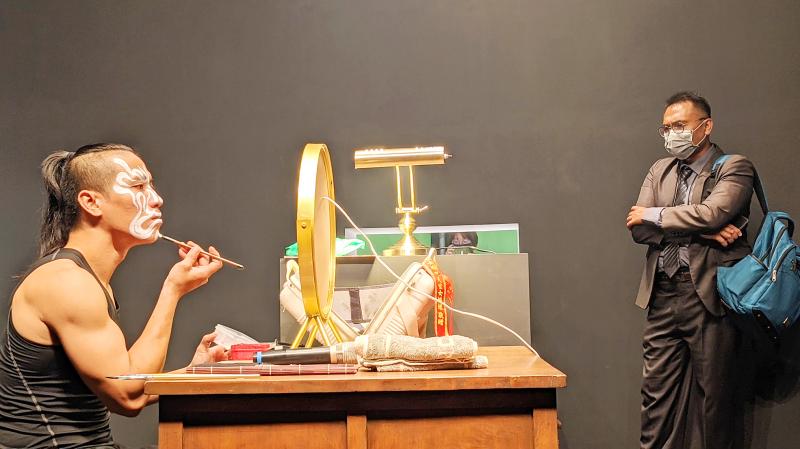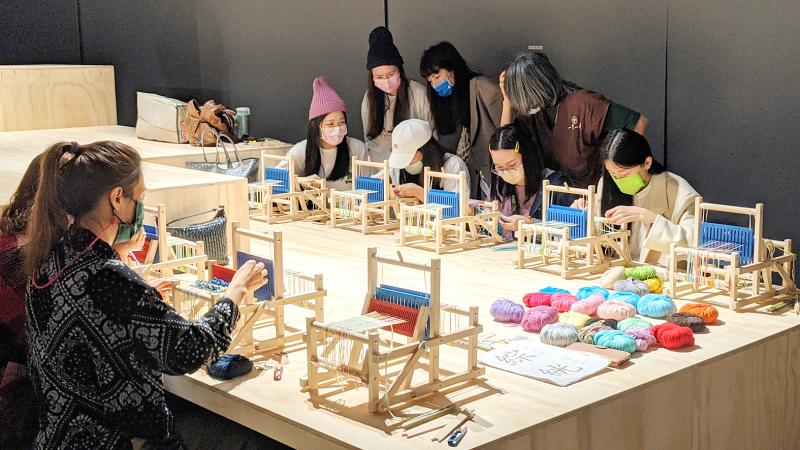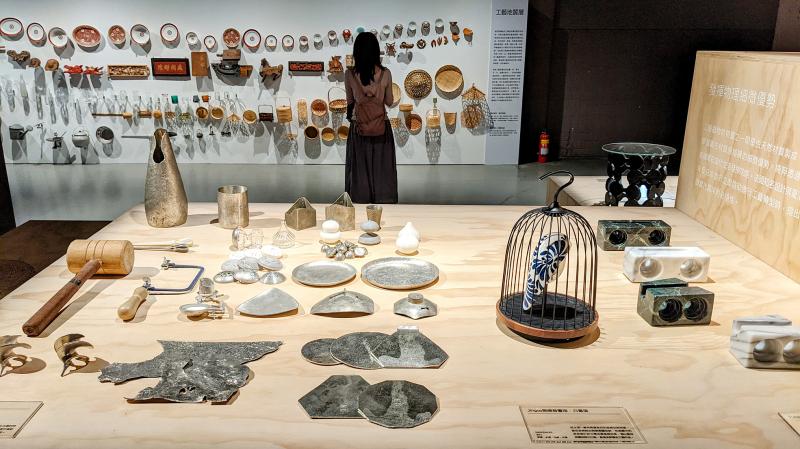Traditional hand puppet carver Lai Yung-ting (賴泳廷) is “competing” with a 3D printer this week in a sleek exhibition hall in downtown Taipei. Lai honed his craft from the age of 17 under the iconic master Lee Tien-lu (李天祿), and there’s no comparing the two even though the machine works precisely and tirelessly.
“This setup lets viewers experience first-hand the challenges that traditional crafts face in the real world,” the placard reads. Lai’s workshop is part of the Craft Land exhibition in the culture section of this year’s Creative Expo Taiwan, which runs until Sunday at several locations in Taipei.
Much of the culture section, located at Huashan 1914 Cultural Park, is overly abstract, focusing too much on artistic concepts instead of conveying information, and the expo overall is entirely geared towards Taiwanese audiences with little to no English translation throughout. But there’s still some intriguing takeaways, especially the emphasis on preserving traditional crafts and promoting sustainability.

Photo courtesy of Han Cheung, Taipei Times
The main hall, “Law of Beliefs,” dedicates its spacious first room to a Taiwanese-style talk show display, where two animated hosts banter incessantly to fancy lights and laser beams. It’s a questionable use of space and one has to be really attuned to local culture to understand what’s going on — being fluent in Mandarin isn’t enough. Meanwhile, viewers are supposed to interact with a chatty “guide” through Facebook messenger, but it keeps asking questions in a cutesy tone that bogs down the viewing experience. It’s supposed to get people thinking about the show’s concepts of self-belief, sharing and so on; perhaps it works for some.
In the next room, a guanjiangshou (官將首) temple troupe performer paints his face against a modern, minimalist backdrop to mostly young viewers sitting on mismatched vintage furniture. He talks about the long hours he put into honing his skills, and laments that few young people are willing to take up the mantle. This would have been a better opening to set the scene as traditional crafts are a significant part of this year’s offerings, especially the creative applications that can help them stay relevant.
A good proportion of sample products in the final room meld tradition with modern design and sustainability. For example, there’s an eco-friendly soap made using ancient techniques, lights made from disused wooden electric poles and stylish paper cut-outs of the Taoist deity Black Tiger General (黑虎將軍).

Photo: Han Cheung, Taipei Times
BRIDGING THE GAP
Craft Land takes the concept further: “Crafts are more than just copying the past, we must stand on the shoulder of giants and find the balance between manual and industrial techniques while continuing to offer solutions to the problems in everyday life.”
Industrial solutions are no longer enough as consumers look toward sustainability and regain an appreciation for handicrafts. There’s still a gap between the two sides, and the show explores ways to bridge it.

Photo: Han Cheung, Taipei Times
Products made from agricultural and industrial waste are already increasingly common; more intriguing are the designers that try to find a middle ground between the warmth of handcrafting and mass production or cutting-edge technology. This can be as simple as a wooden jewelry box whose intricate designs are mostly machine-printed, but the finishing touches are put on manually with lacquer painting and gold powder. Tradition becomes added value this way.
More conceptual are the ceramic wares whose clay formulas and firing time are determined by computer programming, jewelry that is 3D printed but finished with traditional lacquer techniques and recycled glassware that is machine made, but employs a natural technique that creates random patterns on each piece.
The theme continues in the design section, which opened on Wednesday at Songshan Cultural and Creative Park. It’s mostly an expo of interesting made-in-Taiwan goods, but it’s telling that the first hall opens to a display of Yingge pottery created through the Taiwan Design Research Institute’s T22 project, aimed to revive local industries by pairing them with modern designers.

Photo: Han Cheung, Taipei Times
There’s also a special zone for sustainable, recycled products, where I briefly chat with a vendor who has been making seed paper for about a decade. It’s getting easier each year to explain eco-friendly concepts to people, she says, but sustainability should be a lifestyle, not just a trend. That also rings true for the traditional crafts. There’s still not really a solution for young people not wanting to become hand puppet carvers, but it was encouraging to see more businesses trying to integrate time-honored elements into every-day products.

No one saw it coming. Everyone — including the Chinese Nationalist Party (KMT) — expected at least some of the recall campaigns against 24 of its lawmakers and Hsinchu Mayor Ann Kao (高虹安) to succeed. Underground gamblers reportedly expected between five and eight lawmakers to lose their jobs. All of this analysis made sense, but contained a fatal flaw. The record of the recall campaigns, the collapse of the KMT-led recalls, and polling data all pointed to enthusiastic high turnout in support of the recall campaigns, and that those against the recalls were unenthusiastic and far less likely to vote. That

Behind a car repair business on a nondescript Thai street are the cherished pets of a rising TikTok animal influencer: two lions and a 200-kilogram lion-tiger hybrid called “Big George.” Lion ownership is legal in Thailand, and Tharnuwarht Plengkemratch is an enthusiastic advocate, posting updates on his feline companions to nearly three million followers. “They’re playful and affectionate, just like dogs or cats,” he said from inside their cage complex at his home in the northern city of Chiang Mai. Thailand’s captive lion population has exploded in recent years, with nearly 500 registered in zoos, breeding farms, petting cafes and homes. Experts warn the

A couple of weeks ago the parties aligned with the People’s Republic of China (PRC), the Chinese Nationalist Party (KMT) and the Taiwan People’s Party (TPP), voted in the legislature to eliminate the subsidy that enables Taiwan Power Co (Taipower) to keep up with its burgeoning debt, and instead pay for universal cash handouts worth NT$10,000. The subsidy would have been NT$100 billion, while the cash handout had a budget of NT$235 billion. The bill mandates that the cash payments must be completed by Oct. 31 of this year. The changes were part of the overall NT$545 billion budget approved

The unexpected collapse of the recall campaigns is being viewed through many lenses, most of them skewed and self-absorbed. The international media unsurprisingly focuses on what they perceive as the message that Taiwanese voters were sending in the failure of the mass recall, especially to China, the US and to friendly Western nations. This made some sense prior to early last month. One of the main arguments used by recall campaigners for recalling Chinese Nationalist Party (KMT) lawmakers was that they were too pro-China, and by extension not to be trusted with defending the nation. Also by extension, that argument could be